story and photos by Kayte Deioma
Ok. I admit that I can be a bit of a cultural heathen when it comes to visiting the museums of the world, mostly because it means spending the day inside when I want to be out exploring. I traveled to Berlin with my friend Julie Bartolotto, the executive director of the Historical Society of Long Beach, who is in the process of planning a permanent home for the Society’s historical collection a museum. Of course she wants to look at museums, so what can I do? Pray for rain so I won’t feel bad about being inside!
The universe obligingly provides the precipitation, so the next hard decision is which museums to visit. There are 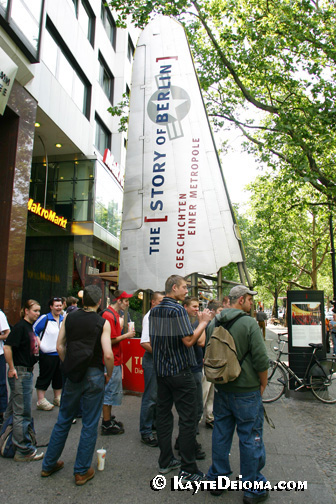 multiple history museums to choose from in Berlin, as well as a panoply of art and culture museums. My interest is sparked by the Story of Berlin museum, which will take us from the city’s inception through it’s times of prosperity, turmoil, division, and reunification up to the present day. If we only get one rainy day, then at least we’ll have an overview of the city’s history.
multiple history museums to choose from in Berlin, as well as a panoply of art and culture museums. My interest is sparked by the Story of Berlin museum, which will take us from the city’s inception through it’s times of prosperity, turmoil, division, and reunification up to the present day. If we only get one rainy day, then at least we’ll have an overview of the city’s history.
The Story of Berlin is a permanent exhibition, opened in 1999, housed in the Ku’Damm Karree shopping center. The location was chosen to incorporate the nuclear fallout shelter built under the complex when it was constructed in the early 70’s. A guided tour of the “atomic bunker” is part of the Story of Berlin experience. Since an English language tour of the bunker is about to begin as we arrive, we decide to start our experience underground.
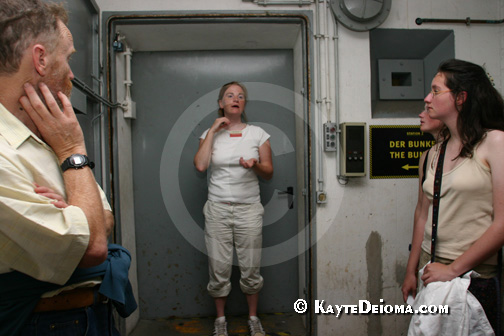 We follow our young guide out of the shopping center and into the parking structure, then down several flights of stairs. We crowd into an antechamber in front of a heavy metal door with the other English-speaking visitors from Georgia, Australia, Denmark and Argentina. We’re in the decontamination chamber. In a brief orientation the guide explains that the bunker was built to house 3592 people. She is refreshingly candid about her opinions of the usefulness of the bunker in a real nuclear crisis, given that it was only stocked with enough supplies to last 14 days. However, the first 3592 people still have someplace to duck for cover in case of current biological or chemical threats which might clear more quickly than nuclear fallout.
We follow our young guide out of the shopping center and into the parking structure, then down several flights of stairs. We crowd into an antechamber in front of a heavy metal door with the other English-speaking visitors from Georgia, Australia, Denmark and Argentina. We’re in the decontamination chamber. In a brief orientation the guide explains that the bunker was built to house 3592 people. She is refreshingly candid about her opinions of the usefulness of the bunker in a real nuclear crisis, given that it was only stocked with enough supplies to last 14 days. However, the first 3592 people still have someplace to duck for cover in case of current biological or chemical threats which might clear more quickly than nuclear fallout.
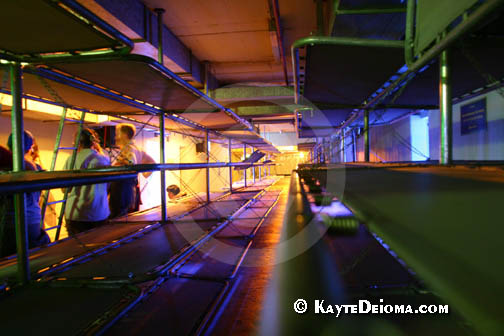 When we pass through the metal door, eerie colored lights hint at the vast expanse of cots hung four deep, floor to ceiling, extending in tight rows into the darkness. Our guide shows us around the perimeter of the room, where glassed-off doors allow a glimpse into men’s and women’s sanitation areas, the 47-bed infirmary, the generator room, the air filtration system and the kitchen full of unlabeled gold cans with a notice on the window stating “no provisions are stored here.”
When we pass through the metal door, eerie colored lights hint at the vast expanse of cots hung four deep, floor to ceiling, extending in tight rows into the darkness. Our guide shows us around the perimeter of the room, where glassed-off doors allow a glimpse into men’s and women’s sanitation areas, the 47-bed infirmary, the generator room, the air filtration system and the kitchen full of unlabeled gold cans with a notice on the window stating “no provisions are stored here.”
The idea of sharing this un-air-conditioned bunker with 3491 other sweaty cranky souls for 14 days only to emerge to…what? Maybe world leaders should have their summits here. Gloomy thoughts for a rainy day. We head back upstairs, through the mall to the main exhibition. We opt not to get the headsets with the narrated tour, but rather to read our way through since everything is in German and English.
We enter the exhibition through a courtyard, representative of the German 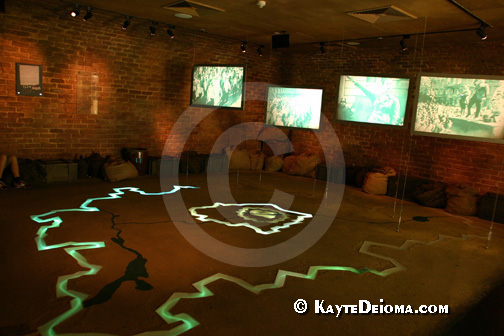 and Turkish people and neighborhoods of the city. A friendly staff person takes our tickets. The inner doors open. We step through into the Time Tunnel stretching ahead of us. To the left, a jagged bull’s-eye of green light on the floor outlines the borders of Berlin at it’s founding in 1237 as a village on the banks of the Spree, and its expanded borders in 1648, 1919 and 1920. That original village is now Berlin’s Museum Island. A video on the wall flashes images and dates of Berlin’s history as a center of trade and commerce accompanied by German narration.
and Turkish people and neighborhoods of the city. A friendly staff person takes our tickets. The inner doors open. We step through into the Time Tunnel stretching ahead of us. To the left, a jagged bull’s-eye of green light on the floor outlines the borders of Berlin at it’s founding in 1237 as a village on the banks of the Spree, and its expanded borders in 1648, 1919 and 1920. That original village is now Berlin’s Museum Island. A video on the wall flashes images and dates of Berlin’s history as a center of trade and commerce accompanied by German narration.
We step across the Time Tunnel hallway into a glowing holographic tube 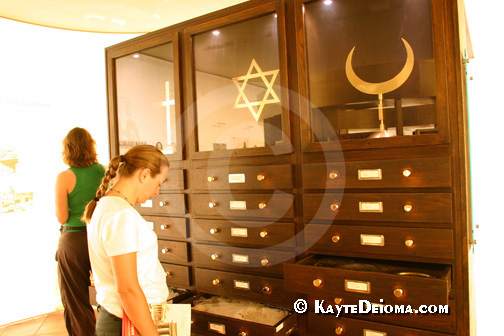 where the entire circular outer wall of back-lit text and illustrations tells the story of how Christianity, Judaism and Islam have influenced the history of the city. In the center of the room, large photographs depicting religious rites surround a tall chest of drawers in three columns topped respectively by a Cross, a Star of David and a Crescent. Each glass-covered drawer contains artifacts used for religious ceremony. In one drawer a Christian baptismal gown, in another a Jewish wedding veil, in a third ritual silver dishes from Ramadan.
where the entire circular outer wall of back-lit text and illustrations tells the story of how Christianity, Judaism and Islam have influenced the history of the city. In the center of the room, large photographs depicting religious rites surround a tall chest of drawers in three columns topped respectively by a Cross, a Star of David and a Crescent. Each glass-covered drawer contains artifacts used for religious ceremony. In one drawer a Christian baptismal gown, in another a Jewish wedding veil, in a third ritual silver dishes from Ramadan.
Back in the Time Tunnel I am a bit overwhelmed by the lists of dates and 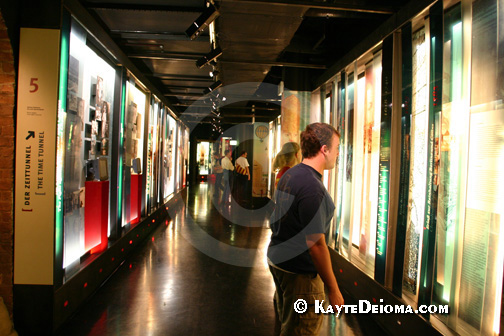 significant events in history and all the interactive panels with video clips. I move on to admire the series of Prussian military uniforms while Julie diligently reads all the important happenings of the 18th century under four rulers named Frederick. Next door, I join life-size figures of the intellectual elite lounging in a Biedermeier room juxtaposed against a wooden barricade with a burning red background. Symbolic of the cultural advances in Berlin before, and the decline after the unsuccessful 1848 revolution.
significant events in history and all the interactive panels with video clips. I move on to admire the series of Prussian military uniforms while Julie diligently reads all the important happenings of the 18th century under four rulers named Frederick. Next door, I join life-size figures of the intellectual elite lounging in a Biedermeier room juxtaposed against a wooden barricade with a burning red background. Symbolic of the cultural advances in Berlin before, and the decline after the unsuccessful 1848 revolution.
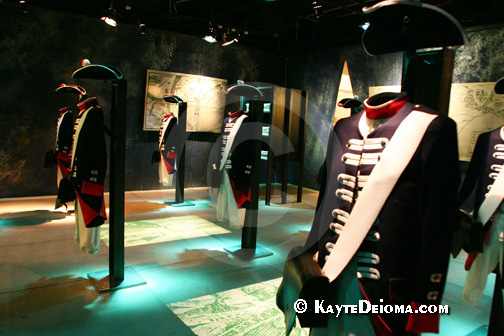 Moving down the hall, a starkly lit display of 23 white architectural models of Berlin’s public buildings shows how the city’s architecture is intertwined with its history. A multimedia display of materials and video monitors depict the changes brought by the industrial revolution. Sporadically assembled artifacts represent the transition to mechanized industry.
Moving down the hall, a starkly lit display of 23 white architectural models of Berlin’s public buildings shows how the city’s architecture is intertwined with its history. A multimedia display of materials and video monitors depict the changes brought by the industrial revolution. Sporadically assembled artifacts represent the transition to mechanized industry.
I follow what look like railroad tracks laid in perspective through a tunnel that dead-ends at a painting of a man beating a horse. I must have missed something. I retrace my steps to see what I’m supposed to be seeing. I should have gotten the headset.
Julie read the panels. The three segments of this “portal” show the 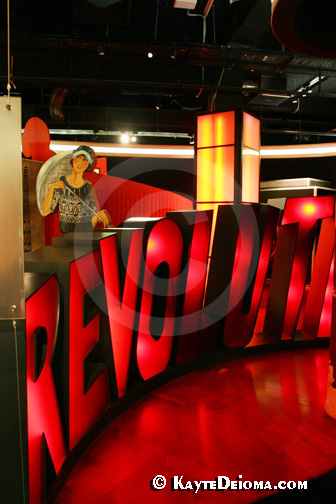 upper class, the middle class and the “urban proletarians” respectively. In the latter segment, where the man is beating the horse, a brightly colored abacus looks out of place among drab metal kitchen utensils set against a backdrop of a life-size black-and-white turn-of-the-last-century photo of a woman with her children. As an example of classism, Julie draws my attention to a painting from the time depicting lower-class townsfolk as a crowd of plump sunbathers, naked babies and groping couples at the beach.
upper class, the middle class and the “urban proletarians” respectively. In the latter segment, where the man is beating the horse, a brightly colored abacus looks out of place among drab metal kitchen utensils set against a backdrop of a life-size black-and-white turn-of-the-last-century photo of a woman with her children. As an example of classism, Julie draws my attention to a painting from the time depicting lower-class townsfolk as a crowd of plump sunbathers, naked babies and groping couples at the beach.
We move through time to a room with a three-wheeled car and cutouts of women from the roaring 20’s behind giant red letters spelling out REVOLUTION. It looks very retro-modern and cool – more concept than content. There’s a little movie theater with a film playing in German. We don’t stop. I must have blinked and missed WWI, or turned the wrong corner. Maybe it was covered in the film. I’m not looking back.
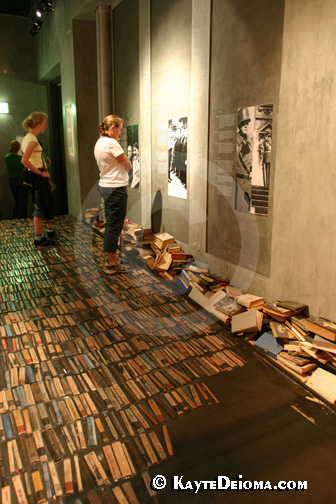 We follow arrows around a corner down a long stairwell plastered with photos of politicians, intellectuals and movie stars. Empty frames indicate those who were lost under the Third Reich. As we descend the stairs, we hear the voices of democratic speeches from above transitioning to the inflammatory speeches of Nazi Germany below. The heavy steel door at the bottom of the dark stairwell forewarns us that we are now entering the darkest chapter in Berlin’s history. On the other side of the door is a hall paved with the spines of books that were burned by the Nazis in 1933. Additional volumes are heaped along the walls. I GET this one, and it GETS me. The goosebumps are starting as I move past the window with “Jude,” German for Jew, scrawled big.
We follow arrows around a corner down a long stairwell plastered with photos of politicians, intellectuals and movie stars. Empty frames indicate those who were lost under the Third Reich. As we descend the stairs, we hear the voices of democratic speeches from above transitioning to the inflammatory speeches of Nazi Germany below. The heavy steel door at the bottom of the dark stairwell forewarns us that we are now entering the darkest chapter in Berlin’s history. On the other side of the door is a hall paved with the spines of books that were burned by the Nazis in 1933. Additional volumes are heaped along the walls. I GET this one, and it GETS me. The goosebumps are starting as I move past the window with “Jude,” German for Jew, scrawled big.
In the Third Reich exhibit, I once again bump up against those high-concept metaphors that I see, but don’t immediately grasp. Aligned footprints on the floor (the masses who went along with everything), swastika turnstiles, a white room (the resistance), a bombed out hole (war and destruction).
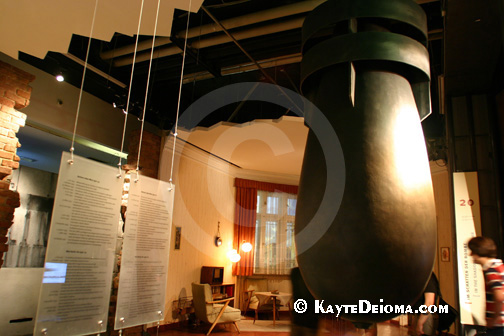 As we move through this period of history, television screens playing historical footage start to appear. They become more prominent as we move past the war into the rebuilding of the 50’s and 60s, including news reports of the Berlin airlift. A display shows two 1950s living rooms representing life in East and West Berlin with a bomb suspended through the ceiling between them. The differences are subtle, the most obvious being the colored TV in the West and black and white in the East.
As we move through this period of history, television screens playing historical footage start to appear. They become more prominent as we move past the war into the rebuilding of the 50’s and 60s, including news reports of the Berlin airlift. A display shows two 1950s living rooms representing life in East and West Berlin with a bomb suspended through the ceiling between them. The differences are subtle, the most obvious being the colored TV in the West and black and white in the East.
The wall is built. In an effective visual presentation, back to back TV sets 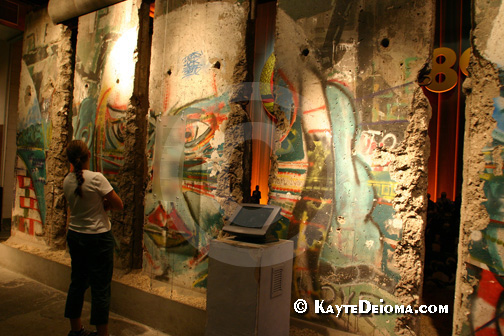 show footage of what surveillance cameras recorded on the East and West sides of the wall. More TV screens show footage of news reports of changes in the Soviet Union. Four segments of the original wall stand here. We hear the voice of Ronald Reagan saying “Mr. Gorbachev, tear down this wall!” as thousands cheer. We see the German and English news reports of GDR secretary general Erich Honecker declaring the borders open between East and West. Hundreds of thousands of people fill the streets and clamber on top of the wall. I’ve held up until now, but the tissue comes out as I remember watching this original footage from my apartment in Glendale, CA.
show footage of what surveillance cameras recorded on the East and West sides of the wall. More TV screens show footage of news reports of changes in the Soviet Union. Four segments of the original wall stand here. We hear the voice of Ronald Reagan saying “Mr. Gorbachev, tear down this wall!” as thousands cheer. We see the German and English news reports of GDR secretary general Erich Honecker declaring the borders open between East and West. Hundreds of thousands of people fill the streets and clamber on top of the wall. I’ve held up until now, but the tissue comes out as I remember watching this original footage from my apartment in Glendale, CA.
I regain my composure and look for Julie, already at the other end of the final room of the exhibit, the rebuilding. I walk past a car – I think it might have been Erich Honecker’s, a moped with a protest banner hanging overhead, a little room with a desk and books piled all around . I’m past my information absorption limit. I tread gratefully over a field of red and green East German traffic-signal men to the elevator back up to the shopping mall and on to lunch.

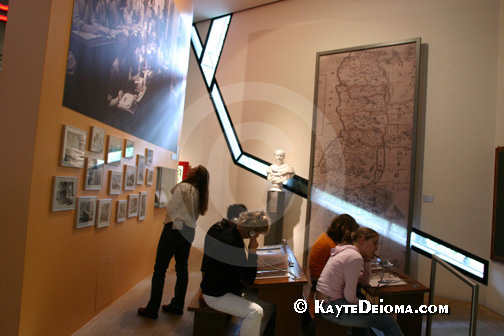 The Holocaust is generally the first thing that comes to my mind when thinking of Jewish history in Germany, and I’m not always in the right frame of mind to re-visit that chapter. Renate assures me that this is just a small part of the many centuries of customs and contributions covered by the Jewish Museum Berlin. It’s raining…the preferred weather for visiting dark subjects.
The Holocaust is generally the first thing that comes to my mind when thinking of Jewish history in Germany, and I’m not always in the right frame of mind to re-visit that chapter. Renate assures me that this is just a small part of the many centuries of customs and contributions covered by the Jewish Museum Berlin. It’s raining…the preferred weather for visiting dark subjects.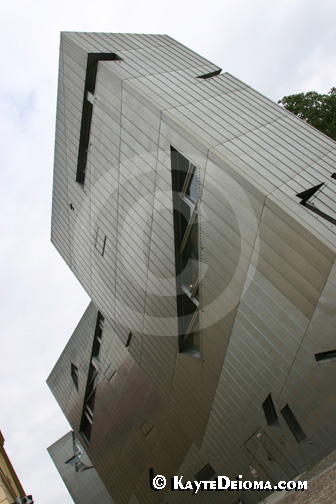 We take the subway to Klosterstrasse and walk east to Lindenstrasse. The new Jewish Museum building is a violently angular structure, with zigzagging windows slicing scars across its metal surface. You have to gain a bit of distance from the edifice to really appreciate its sculpted construction. The original Baroque façade of the entrance is jarring next to the drama of its jagged zinc-paneled offspring. It is certainly a building that makes you ask “Why this?” and go about trying to find an answer.
We take the subway to Klosterstrasse and walk east to Lindenstrasse. The new Jewish Museum building is a violently angular structure, with zigzagging windows slicing scars across its metal surface. You have to gain a bit of distance from the edifice to really appreciate its sculpted construction. The original Baroque façade of the entrance is jarring next to the drama of its jagged zinc-paneled offspring. It is certainly a building that makes you ask “Why this?” and go about trying to find an answer.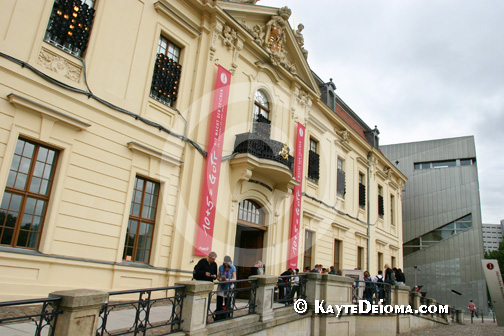 bookshop or a guided architectural tour give insight into architect Daniel Libeskind’s complex concept. His design is based on interconnected points in German and Jewish history forming a deconstructed star, an unfinished Schoenberg opera, a text by Walter Benjamin, and the void left in Berlin by the loss of all the deported Jews and their cultural and intellectual contributions. That’s a lot of concept to be executed in an architectural structure.
bookshop or a guided architectural tour give insight into architect Daniel Libeskind’s complex concept. His design is based on interconnected points in German and Jewish history forming a deconstructed star, an unfinished Schoenberg opera, a text by Walter Benjamin, and the void left in Berlin by the loss of all the deported Jews and their cultural and intellectual contributions. That’s a lot of concept to be executed in an architectural structure.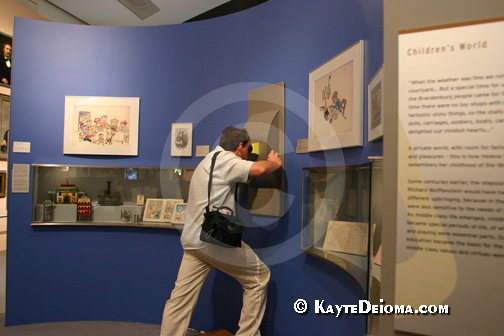 museum maps. A brochure describes 13 different guided tours you can choose from with different themes, two specifically for young children 5 to 7 and 8 to 11. Rather than wait for a tour (which one out of so many?), we decide to explore on our own.
museum maps. A brochure describes 13 different guided tours you can choose from with different themes, two specifically for young children 5 to 7 and 8 to 11. Rather than wait for a tour (which one out of so many?), we decide to explore on our own.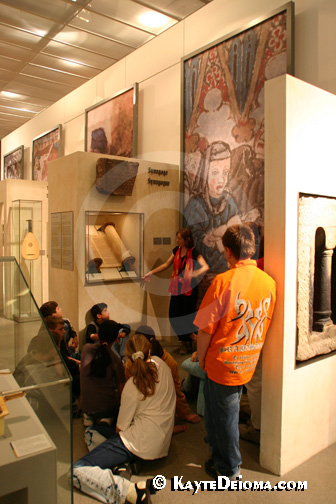 I was never very good in history. I can remember the sense and feel of important historical events, but not the names, places or dates. The exhibition at the Jewish Museum Berlin was designed for people like me. The dates and names are there, but the substance is in the sense and feel and experience. Starting upstairs in the middle ages, we walk though narrow aisles with displays of paintings and artifacts representing trade, diversion and religious practice.
I was never very good in history. I can remember the sense and feel of important historical events, but not the names, places or dates. The exhibition at the Jewish Museum Berlin was designed for people like me. The dates and names are there, but the substance is in the sense and feel and experience. Starting upstairs in the middle ages, we walk though narrow aisles with displays of paintings and artifacts representing trade, diversion and religious practice.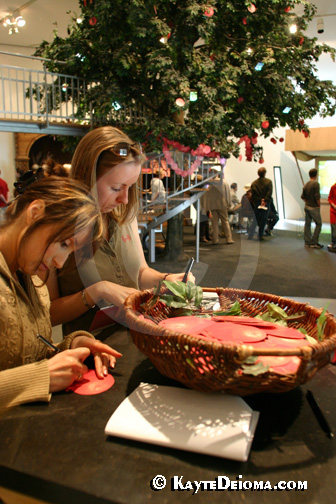 leading up the trunk. We are directed to write a wish on a piece of paper and tie it to the tree and our wish will come true. Rumor has it that the original apple tree in the Garden of Eden was a pomegranate, but I’m not sure how “lucky” that was, since it cast us out of paradise. However, I am not one to turn down a free wish. I write down my wish and look for an auspicious branch to tie it to. Renate finds a nice low branch for hers. Julie and I climb up the spiral stairs deep into the branches to tie our wishes. After all, how often do you have the luxury of a spiral staircase when you want to climb a tree?
leading up the trunk. We are directed to write a wish on a piece of paper and tie it to the tree and our wish will come true. Rumor has it that the original apple tree in the Garden of Eden was a pomegranate, but I’m not sure how “lucky” that was, since it cast us out of paradise. However, I am not one to turn down a free wish. I write down my wish and look for an auspicious branch to tie it to. Renate finds a nice low branch for hers. Julie and I climb up the spiral stairs deep into the branches to tie our wishes. After all, how often do you have the luxury of a spiral staircase when you want to climb a tree?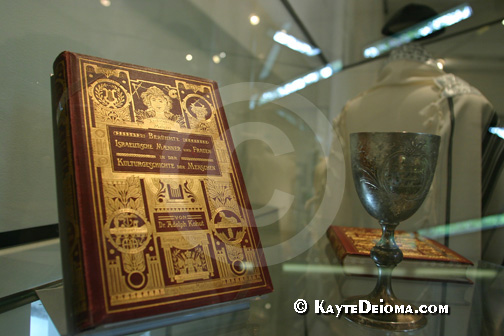 lead us through the centuries. Interactive exhibits let me write out my name in Hebrew, help a tradeswoman pack for a business trip and listen to recordings of speeches by Albert Einstein. Information panels take us through the bureaucratic decisions leading to the extermination of German Jews. Stories of loss, resistance and survival
lead us through the centuries. Interactive exhibits let me write out my name in Hebrew, help a tradeswoman pack for a business trip and listen to recordings of speeches by Albert Einstein. Information panels take us through the bureaucratic decisions leading to the extermination of German Jews. Stories of loss, resistance and survival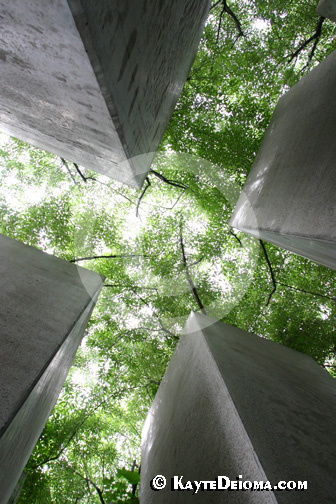 graphic architectural interpretation of the darkest part of Jewish history in Berlin. Three wide, empty, sloping corridors crisscross the lower level. One corridor is labeled the Axis of Exile representing the exile and emigration of Jews from Germany. On the wall is a sparse collection of artifacts that a family was able to take with them leaving Berlin. This Axis leads outside to the Garden of Exile. The garden is a grid of 48 concrete pillars filled with Berlin soil with trees growing out the top, and the 49 th pillar with soil from Jerusalem.
graphic architectural interpretation of the darkest part of Jewish history in Berlin. Three wide, empty, sloping corridors crisscross the lower level. One corridor is labeled the Axis of Exile representing the exile and emigration of Jews from Germany. On the wall is a sparse collection of artifacts that a family was able to take with them leaving Berlin. This Axis leads outside to the Garden of Exile. The garden is a grid of 48 concrete pillars filled with Berlin soil with trees growing out the top, and the 49 th pillar with soil from Jerusalem.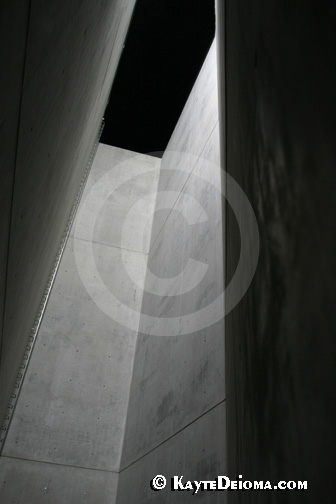 dead-ends at a void. This is a dark columnar room with a small opening of light at the top. We are allowed to enter, a couple people at a time, to experience the feeling of being cut off from the world outside. The third and longest corridor is the Axis of continuity, which connects the entrance/exit in the old Baroque museum building climbing steeply upward back to the exhibition space. There is not a natural path to lead you through these corridors, so we end up backtracking and miss a few turns.
dead-ends at a void. This is a dark columnar room with a small opening of light at the top. We are allowed to enter, a couple people at a time, to experience the feeling of being cut off from the world outside. The third and longest corridor is the Axis of continuity, which connects the entrance/exit in the old Baroque museum building climbing steeply upward back to the exhibition space. There is not a natural path to lead you through these corridors, so we end up backtracking and miss a few turns.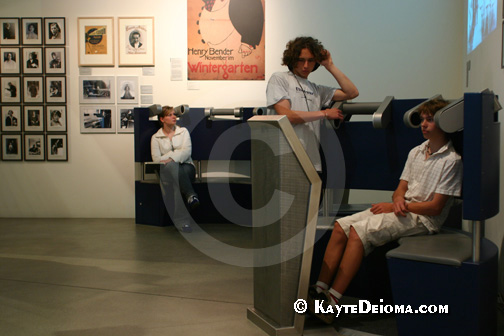 Winderoll to minimize museum fatigue among visitors, we have absorbed our fill. In searching for a restroom, which is not the easiest thing to find, we stumble across a coffee vendor and stop to have a welcome cup of coffee on the one available bench in front of the kosher Gummi Bear machine. A café would be nice, but we are happy to rest our feet for a few minutes and share our impressions of the museum before facing the rainy walk back to the subway.
Winderoll to minimize museum fatigue among visitors, we have absorbed our fill. In searching for a restroom, which is not the easiest thing to find, we stumble across a coffee vendor and stop to have a welcome cup of coffee on the one available bench in front of the kosher Gummi Bear machine. A café would be nice, but we are happy to rest our feet for a few minutes and share our impressions of the museum before facing the rainy walk back to the subway.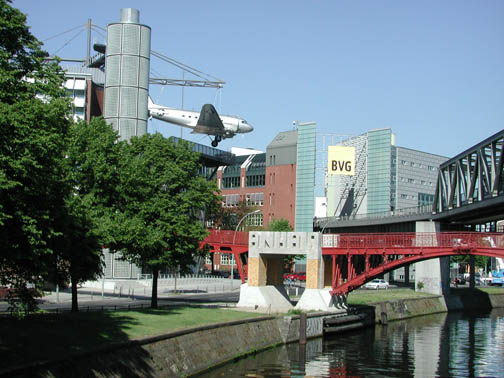 The German Museum of Technology in Berlin, located in old railroad and factory buildings in Kreuzberg, is a fun place to go with kids. There are lots of hands on activities. Visitors can actively print, make paper, shred grain or watch suitcases being made out of cardboard in the suitcase production line.
The German Museum of Technology in Berlin, located in old railroad and factory buildings in Kreuzberg, is a fun place to go with kids. There are lots of hands on activities. Visitors can actively print, make paper, shred grain or watch suitcases being made out of cardboard in the suitcase production line.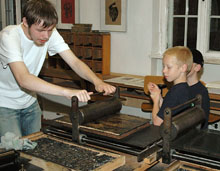 Take your umbrella, there is plenty to explore outdoors between buildings, especially in the Museum Park. “Millers explain their old craft in the fully functional trestle windmill dating from 1820 or the Dutch windmill from 1911. An undershot water-wheel at the mill pond drives a historical forge. The historical brewery casts light on the art of brewing around 1910.”
Take your umbrella, there is plenty to explore outdoors between buildings, especially in the Museum Park. “Millers explain their old craft in the fully functional trestle windmill dating from 1820 or the Dutch windmill from 1911. An undershot water-wheel at the mill pond drives a historical forge. The historical brewery casts light on the art of brewing around 1910.”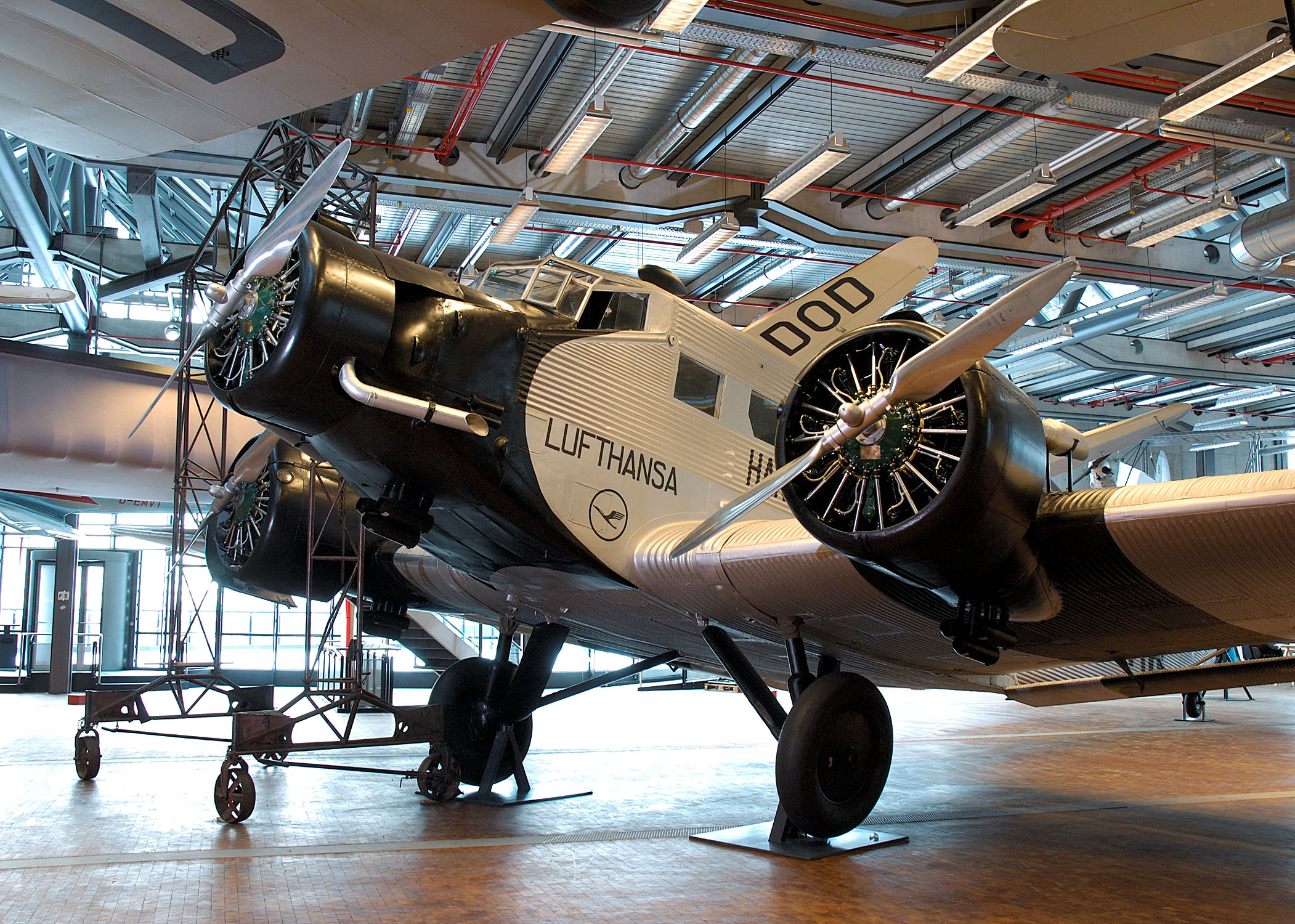 This month the Museum opens a new permanent Air and Space Travel Exhibition. The official open house for the new exhibition is April 16, 2005.
This month the Museum opens a new permanent Air and Space Travel Exhibition. The official open house for the new exhibition is April 16, 2005.